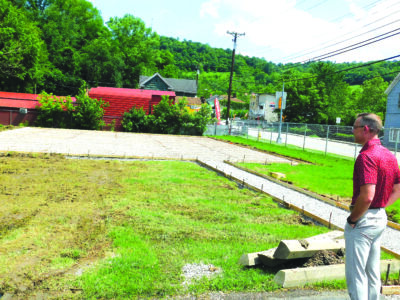Study: Housing prices impacted
PARKERSBURG – Oil and gas exploration in Colorado’s Front Range near the Rocky Mountains negatively impacts house prices, according to study by a professor at the West Virginia University Davis College of Agriculture.
Heather Stephens, an assistant professor of resource economics and management, analyzed housing sales from 2006 to 2014 in the Front Range region and found homes with private water sources have lower valuations because of concern with groundwater contamination from nearby wells. She and Amanda Weinstein of the University of Akron wrote about the study in an article published Oct. 16, “Household valuation of energy development in amenity-rich regions,” in the journal “Growth and Change.”
“We find that shale development activity lowers housing prices, providing some evidence that residents in Colorado negatively value this activity,” Stephens said in a release from the university.
Most research on the impact on housing values from shale development is based on data from Pennsylvania, which suggests only residents with private water supplies have a negative view of drilling, Stephens said.
However, Coloradoans in Stephens’ study have a more widely shared negative view.
“The research finds that the value local residents place on shale development varies based on the attitudes of residents, as well as the presence of natural amenities,” Stephens said. “We find that drilling negatively affects the value of proximity to the mountains and mountain views. We also find competition for housing as well and housing developments compete for land and are increasingly in close proximity to each other.”
Stephens and Weinstein focused on Colorado as a contrast to Pennsylvania. Colorado has undergone a population and housing boom and residents there tend to value natural amenities and environmental protection more, Stephens said.
“We need to have a more nuanced look at local areas and not just assume what was found in Pennsylvania is going to apply everywhere,” she said. “With this project, we thought, ‘Why not research some place different?’ So that if we got the same results, we could start generalizing that this is what you’ll find across the whole U.S.”
The findings indicate there’s cultural differences between residents of Front Range the region of Colorado and the shale region of West Virginia, Ohio and Pennsylvania, both Greg Kozera, executive director of Shale Crescent USA, and Charlie Burd, executive director of the Independent Oil and Gas Association of West Virginia, said. The non-profit Shale Crescent promotes natural gas production and economic development in the Marcellus and Utica shale regions of West Virginia, Ohio and Pennsylvania.
Residents in this region, where there has been oil and gas drilling since the 19th century, have a different more, accepting perspective to oil and gas drilling, they said.
“Maybe we’re more used to this stuff,” Kozera said.
Residents here do have concerns with contamination of their water wells, Burd said. In West Virginia, before a well is drilled, tests are required before and after if the wells are within a half-mile of a water source, he said.
“There are safeguards in West Virginia,” Burd said.
Also, Kozera said property values in the Ohio Valley region have not been devalued from oil and gas development in the shale region.
“It certainly hasn’t in this part of the world,” he said.
However, another difference between the two regions is the terrain, according to Stephens. Wells may be less visible in this area, she said.
“If you live in Pennsylvania or West Virginia, you may not be able to see wells from your house. If I live over a hill, I may not realize a well is nearby,” Stephens, who also is participating in research into the impact of shale development in West Virginia, said. “But on the Front Range in Colorado, it’s very flat, and then there’s the Rockies. You can see wells more clearly.”
Oil and gas development has positive results including lower energy prices, but the costs of development fall on nearby residents and communities, she said.
“An expansion of oil and gas production in an amenity-rich area will affect the natural capital of the area, thus there is a substitution effect between increased growth from shale oil and gas development and a reduction in the value of amenities,” Stephens said. “As shale development increases, policy makers may need to consider policies to address this substitution effect and to maintain or even improve upon the natural capital of these areas. Investing the immediate gains, through severance taxes or other fees, from oil and gas extraction into the natural capital of these areas may help ensure these amenity-rich areas maintain their quality of life and continue to experience growth in the long term.”
Higher production of natural gas in the Marcellus and Utica shales has saved consumers have saved $1.1 trillion since 2008 because of natural gas production increases in the Marcellus and Utica shale reserves, among the largest in the world, in West Virginia, Ohio and Pennsylvania, according to a report by the Shale Crescent USA and the Gas Energy Education Program, “Natural Gas Savings to End-Users.”
The average household saved more than $4,000 over the past 10 years and industrial users in the region saved about $25 billion since 2008, according to Jerry Fames, a co-founder of the Shale Crescent USA.
“The strength of natural gas and natural gas liquids production in the Shale Crescent region, as this report confirms, has made this region the most profitable place to build a petrochemical plant, giving manufacturers here a critical competitive edge,” he said.




